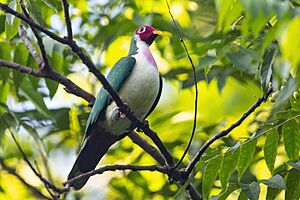Jambu fruit dove facts for kids
Quick facts for kids Jambu fruit dove |
|
|---|---|
 |
|
| Conservation status | |
| Scientific classification | |
| Genus: |
Ptilinopus
|
| Species: |
jambu
|
The jambu fruit dove (Ptilinopus jambu) is a small, very colorful bird. It's a type of fruit dove, which means it mostly eats fruit. You can find these doves living in places like southern Thailand, Malaysia, Brunei, and the Indonesian islands of Kalimantan, Sumatra, and Java. It's the only species in its group, which makes it special.
Contents
How the Jambu Fruit Dove Got Its Name
The jambu fruit dove was first officially described in 1789. A German scientist named Johann Friedrich Gmelin gave it its scientific name. He put it in the same group as other doves and pigeons at the time.
The name "jambu" comes from the Malay language. In Malay, the bird is called Punai jambu. This name refers to the color of the bird's head. It looks like the flower of the Malay rose apple tree, which is also called jambu merah. That's how this unique bird got its specific name!
What Does a Jambu Fruit Dove Look Like?
The jambu fruit dove is about 23 to 27 centimeters (9 to 11 inches) long. It weighs around 42 grams (1.5 ounces). This bird is plump with a small head and soft feathers. Both males and females have a white ring around their eyes. They also have an orange beak and red legs.
Male and Female Differences
Adult male jambu fruit doves are very striking. They have a bright crimson (deep red) face and a black chin. Their upper body is dark green, and their belly is an ivory white. They also have a pink patch on their chest and a chocolate brown area under their tail.
Female jambu fruit doves look a bit different. Their face is a dull purple, and they have a dark chin. Their upper body is also green, but their belly is white. The area under their tail is cinnamon or buff colored.
Young Jambu Fruit Doves
Young jambu fruit doves look similar to the females. However, their face is green instead of purple. Young males will get their full bright adult colors later. This usually happens about 39 weeks after they leave the nest. The call of this dove is a soft, low "coo" sound.
Where Do Jambu Fruit Doves Live?
You can find the jambu fruit dove in several places. These include the Malay Peninsula and the island of Sumatra. They also live on islands like Nias, Bangka, and Belitung. They are also found on Borneo and possibly in western Java.
These doves prefer to live in mangrove swamps. They also like lowland rain forests, up to about 1,500 meters (4,900 feet) high. Sometimes, they can be found in forests that have grown back after being cut down.
How Jambu Fruit Doves Behave
The jambu fruit dove is a shy bird. Its green feathers help it blend in with the forest trees. This makes it hard to spot! You usually see them alone or in pairs. However, many doves might gather together if they find a fruit tree with lots of food.
They eat fruit directly from the tree. They might also eat fruit that has fallen to the ground. Sometimes, other animals like hornbills or monkeys drop fruit. Like other doves, they can drink water by sucking it up. Most birds have to tilt their heads back to swallow.
Reproduction and Life Cycle
Male jambu fruit doves claim a special area for breeding. They show off by raising their wings and bobbing their bodies. They also make cooing sounds to attract a mate. If another bird tries to enter their space, they might quickly peck at it.
The female dove builds a simple nest. It's made of twigs, roots, and grasses. The male helps by collecting these materials for her. She usually lays one or sometimes two white eggs. The eggs hatch after about 20 days. The young doves then stay in the nest for another 12 days or more before they are ready to fly.
Jambu Fruit Doves and People
Some people have special beliefs about the jambu fruit dove. The Temoq people in Pahang, Malaysia, believe something interesting. They think that the female jambu fruit dove is a form of their creator ancestor, Maq Sidi.
Protecting the Jambu Fruit Dove
Sadly, the jambu fruit dove is facing some challenges. A lot of forests in Indonesia and Malaysia are being cut down. This is called deforestation. It means the doves are losing their homes.
However, these doves can live in forests that are growing back. They can also live at higher elevations. This helps them more than some other forest birds. Because of these threats, the jambu fruit dove is listed as "Near Threatened" on the IUCN Red List. This means they are not in immediate danger, but their numbers are decreasing, and they need our help to protect their homes.


